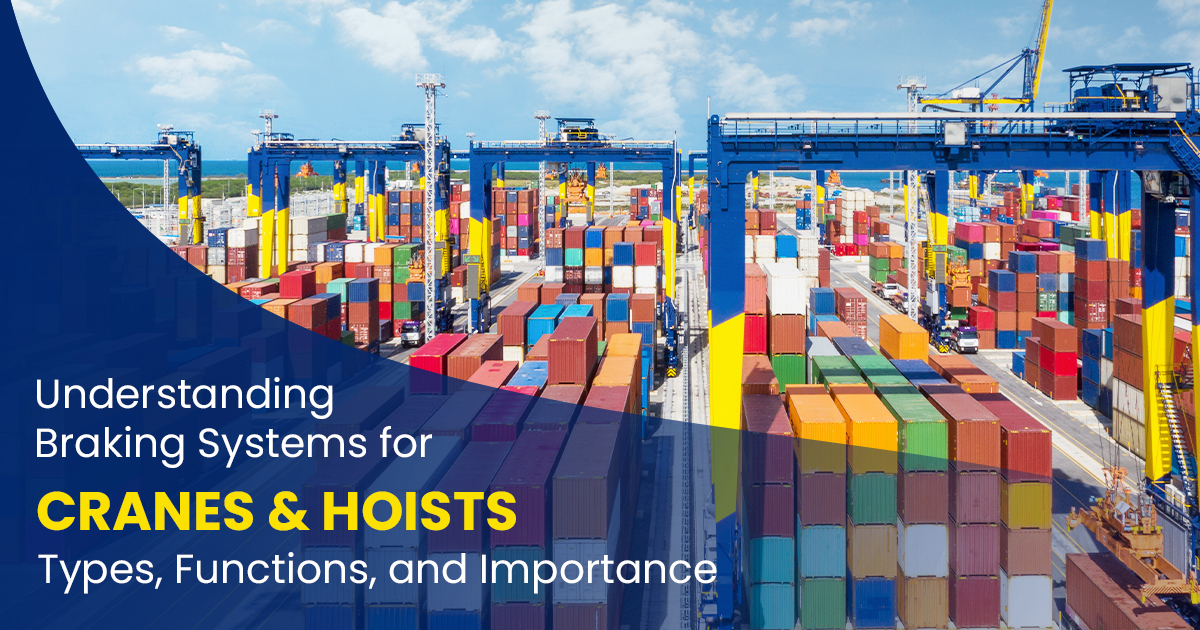
Understanding Braking Systems for Cranes & Hoists: Types, Functions, and Importance
- April 08, 2025
- by
- bhavik@bcreative.in
Did you know that a crane that does not have an effective braking system is a disaster waiting to occur? The braking system for cranes and hoists is one of the most important features, providing secure and controlled motion of heavy loads. From an EOT (Electric Overhead Traveling) crane to a basic hoist, a proper crane brake system can make the difference between risk-free operations and a complete disaster.
Why Are Braking Systems Important in Cranes and Hoists?
Suppose a crane is hoisting a heavy load, and the movement just refuses to stop when it needs to. Scary thought, isn’t it? That’s exactly why the crane hoist brake system is so important. It prevents unnecessary, uncontrolled motion, provides safety, and enhances load-handling accuracy.
A well-working braking system:
- Enhances safety: Prevents accidents caused by free-falling loads.
- Enhances efficiency: It minimizes wear and tear by managing movement efficiently.
- Extends equipment life: It saves gears and motors from overworking.
- Ensures compliance: Complies with industrial safety standards to prevent fines and legal problems.
Types of Braking Systems in Cranes & Hoists
Brakes used in hoists and cranes are engineered according to their application and the load capacity they are designed to handle. Here are the most commonly used braking systems:
1. Electro-Mechanical Brakes
Electro-mechanical brakes are becoming increasingly popular in modern overhead crane systems due to their precise control and high reliability. Mechanical brakes are dependable, but they should be maintained to prevent wear and tear.
2. Hydraulic Brakes
Hydraulic brakes use fluid pressure to create braking force. Hydraulic brakes are generally employed in heavy-duty cranes where strong braking action is needed.
3. Electromagnetic Brakes
Electromagnetic brakes are common in EOT crane parts that utilize an electric current to activate or deactivate the brake system. EM brakes use an electromagnetic field produced by the internal stator coil.
4. Fail-Safe Brakes
Spring-loaded brakes are also referred to as fail-safe brakes. They are made to engage automatically in case of power failure. The function makes them critical for safety-critical applications.
Selecting the Right Braking System
The right crane brake selection depends on load capacity, operating conditions, and frequency of use. Steel works or shipyards require hydraulic or fail-safe brakes for cranes under heavy-duty applications, while lighter EOT cranes are effectively operated using electromagnetic braking systems.
Maintenance Tips for Crane Hoist Brakes
Keep the brakes serviced regularly to ensure optimal performance and long life for the braking system. Keep these key points in mind:
- Regular inspections: Inspect the brake linings and pads for wear and tear.
- Lubrication: Maintain moving parts well-lubricated to minimize friction.
- Verify power supply: Provide correct voltage and current flow in electromagnetic brakes.
- Check braking response: Any delay in braking should be rectified immediately.
A properly maintained crane hoist brake system is not only an operational requirement—it’s a safety requirement. Spending money on quality EOT crane parts and regular maintenance can avoid unplanned downtimes and accidents.
Looking to upgrade or maintain your crane’s braking system? Get in touch with us today for expert solutions tailored to your industrial needs. We at Emco Precima also offer premium brakes, ensuring superior performance, durability, and safety for your operations!






